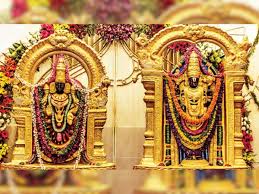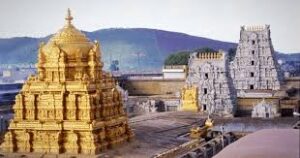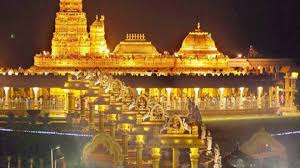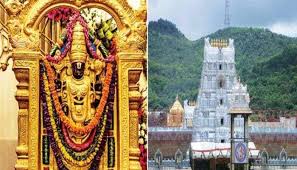Discover Tirupati Temple in Andhra Pradesh: A Spiritual Journey to Sri Venkateswara Swamy Temple
Description:
“Explore the sacred Tirupati Temple in Andhra Pradesh, home to Sri Venkateswara Swamy. Discover its spiritual significance, rich history, and divine atmosphere.”
Tirupati Temple, located in the hill town of Tirumala in the Chittoor district of Andhra Pradesh, Discover Tirupati Temple in Andhra Pradesh: A Spiritual Journey to Sri Venkateswara Swamy Temple is one of the most visited and revered pilgrimage sites in the world Discover Tirupati Temple in Andhra Pradesh: A Spiritual Journey to Sri Venkateswara Swamy Temple. Officially known as the Sri Venkateswara Swamy Temple, it attracts millions of devotees annually who come to seek blessings from Lord Venkateswara, a form of the Hindu god Vishnu.

Why Visit Tirupati Temple?
Tirupati Temple is not only a religious landmark but also a cultural and historical treasure. Discover Tirupati Temple in Andhra Pradesh: A Spiritual Journey to Sri Venkateswara Swamy Temple Known for its rich traditions, ancient architecture, and spiritual significance, it is regarded as the “Spiritual Capital of Andhra Pradesh”. The temple sits atop the Seshachalam Hills at about 853 meters above sea level, offering breathtaking views and a deeply serene atmosphere. Discover Tirupati Temple in Andhra Pradesh: A Spiritual Journey to Sri Venkateswara Swamy Temple.
Key Highlights of the Tirupati Temple
- Deity: Lord Venkateswara, also called Balaji or Srinivasa
- Architecture: Dravidian style with intricately carved gopurams (temple towers)
- Laddu Prasadam: Famous temple offering, known for its unique taste and sacred value
History and Significance

According to legends, Lord Venkateswara appeared on Earth to save humanity from the trials of the Kali YugaDiscover Tirupati Temple in Andhra Pradesh: A Spiritual Journey to Sri Venkateswara Swamy Temple. The Tirupati Balaji Temple is believed to have been built over a thousand years ago, with contributions from the Pallavas, Cholas, Pandyas, and Vijayanagara emperors.
The temple is managed by the Tirumala Tirupati Devasthanams (TTD), an independent trust that oversees all religious and administrative activities.https://discovershpere.in/category/science-technology/
Best Time to Visit Tirupati Temple

Brahmotsavam attract huge crowds and offer a deeper insight into the spiritual fervor of the region.
How to Reach Tirupati Temple
- By Train: Tirupati Railway Station is a major hub in South India.
- By Road: Excellent bus and taxi services from cities like Chennai, Bangalore, and Hyderabad.
Tips for Devotees

- Book darshan tickets in advance via the official TTD website.
- Dress modestly and respect temple traditions.
- Consider trekking the Alipiri or Srivari Mettu footpaths for a traditional pilgrimage experience.
- Don’t miss the free meals (Annadanam) provided by the temple to lakhs of devotees every day
Would you like this article formatted for a website or blog, or need it translated into another language?
The Tirupati Temple, also known as the Sri Venkateswara Swamy Temple, is special for several reasons, making it one of the most revered and visited pilgrimage sites in the world. Here are some of the key aspects that make this temple unique:
1. Spiritual Significance
- The deity is believed to have appeared to save mankind from the challenges of the Kali Yuga.
- The temple’s immense popularity makes it one of the richest and most visited places of worship globally, drawing millions of pilgrims annually.
2. Sacred Location – Tirumala Hills
- The temple is located in Tirumala, a hill station in the Chittoor district of Andhra Pradesh, situated at an altitude of around 853 meters above sea level.

3. Historical and Cultural Significance
- The temple has a rich historical legacy, with references to the temple and its rituals dating back over a thousand yearsDiscover Tirupati Temple in Andhra Pradesh: A Spiritual Journey to Sri Venkateswara Swamy Temple. It has been a site of continuous worship since ancient times and has received contributions from several dynasties, including the Pallavas, Cholas, and Vijayanagara Empire.
- The rituals, ceremonies, and cultural practices observed at the temple are steeped in tradition, and many are performed daily with unwavering devotion.
4. Unique Rituals and Sevas (Services)
- The daily rituals performed at the temple are a major attraction for devotees. These include Suprabhatam, Thomala Seva, Archana, and Ekanta Seva, which are aimed at invoking the blessings of Lord Venkateswara.
- Special festivals, such as the Brahmotsavam, Vaikunta Ekadasi, and Rathotsavam, draw thousands of devotees, who participate in grand processions and devotional practices.

5. Laddu Prasadam
- The Laddu offered as prasadam (holy offering) in the temple is one of the most famous and sought-after religious sweets in IndiaDiscover Tirupati Temple in Andhra Pradesh: A Spiritual Journey to Sri Venkateswara Swamy Temple. Made of besan (gram flour), ghee, and sugar, this divine offering is considered sacred, and devotees believe that receiving a Laddu from the temple brings spiritual fulfillment and divine blessings.
- The Laddu is also unique in that it is only prepared in the temple and cannot be found anywhere else, making it a significant part of the pilgrimage experience.
6. Wealth and Charity
The TTD is renowned for its charitable work, including Annadanam (free meals) served to millions of devotees daily. The temple also supports educational and healthcare initiatives for the underprivileged.
- The temple is known to generate large donations, making it one of the richest places of worship in the world, and a significant portion of the funds is used for social causes.
7. The Mystery of the Lord’s Idol
- The idol of Lord Venkateswara in the temple is unique in that it is believed to have been self-manifested (Svayambhu) and not sculpted by human handsDiscover Tirupati Temple in Andhra Pradesh: A Spiritual Journey to Sri Venkateswara Swamy Temple. The deity’s image is revered for its divine aura, and many devotees claim to feel a special connection with the idol.
- The mysterious nature of the idol is also a point of fascination. The ‘hair’ of the deity is said to grow over time, which adds to the temple’s mystique.
8. Pilgrimage Experience

- The pilgrimage journey to the temple itself is an experience. Devotees often undertake a trek up the Alipiri or Srivari Mettu footpaths as a mark of devotion, offering prayers and completing the spiritual journey on foot, which adds a sense of sacrifice and piety.
- The Tirumala Temple’s rituals encourage devotees to reflect on spiritual matters and engage in prayerful contemplation, providing an environment for self-discovery and devotion.
9. The Architecture of the Temple
- The architecture of the Sri Venkateswara Temple is a fine example of Dravidian style, with intricately carved pillars, gopurams (temple towers), and mandapams (halls). The grandeur of the temple complex and its ornate sculptures reflect the artistic and architectural excellence of South Indian temples.
- The golden dome (Ananda Nilayam) above the main sanctum is a notable feature and adds to the temple’s beauty and divine presence.
10. Accessibility and Convenience
- The Tirupati Temple is easily accessible from major cities in South India, including Chennai, Bangalore, and Hyderabad, by air, train, or road.
- The Tirumala Tirupati Devasthanams (TTD) has made several efforts to make the pilgrimage more convenient, offering facilities like online ticket booking, free bus services, accommodation, and medical assistance to ensure a hassle-free visit for devotees.
The Tirupati Temple (Sri Venkateswara Swamy Temple) was closed for 12 years in the 16th century due to a series of significant historical events. Here’s a brief explanation of why the temple was closed for such an extended period:👉 https://tirumala.org/
1. Mughal Invasions
- During the early 16th century, the southern region of India faced the threat of invasions by Muslim rulers, particularly the Bijapur Sultanate and Mughal EmpireDiscover Tirupati Temple in Andhra Pradesh: A Spiritual Journey to Sri Venkateswara Swamy Temple. The temple, being a significant religious and cultural center, became a target for looting and destruction.
- Sultanate forces, led by Sultan of Bijapur, Adil Shah, and later Aurangzeb’s forces, attacked the region, including the temple, and looted its wealth, including valuable gold and jewels. The invaders sought to deplete the riches of the temple, which had accumulated over centuries from the donations of devotees.

2. Vijayanagara Empire’s Decline
- The Vijayanagara Empire, which had long supported the Tirupati Temple and maintained its operations, began to decline after the Battle of Talikota in 1565, where the empire suffered a significant defeat Discover Tirupati Temple in Andhra Pradesh: A Spiritual Journey to Sri Venkateswara Swamy Temple. The aftermath of this battle led to the weakening of the empire and its ability to protect the temple.
- During this period of instability, the temple’s operations were severely affected, leading to a temporary shutdown of services.
3. Internal Strife and Management Issues
- The temple faced internal administrative challenges during this time. The management of the temple, which had once been handled by the Vijayanagara emperors and local rulers, became disrupted Discover Tirupati Temple in Andhra Pradesh: A Spiritual Journey to Sri Venkateswara Swamy Temple. This, combined with the broader political and social upheaval, led to a halt in the regular rituals and ceremonies.
- With no stable leadership or protection, the temple was closed for repairs and protection against further looting.
4. Restoration and Reopening
- After this long period of closure, the temple was restored and reopened in the 17th century.
- The restoration efforts involved rebuilding the temple structure and re-establishing the rituals and traditions that had been disrupted Discover Tirupati Temple in Andhra Pradesh: A Spiritual Journey to Sri Venkateswara Swamy Temple. Devotees once again began to visit the temple, and it regained its status as one of the most important pilgrimage sites in India.

No Responses